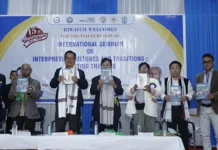[ Suhash Chakma ]
I have read the Facebook post of union MoS (Independent) for Sports & Youth Affairs, Kiren Rijiju, on the Citizenship (Amendment) Act (CAA), 2019, and its applicability in Arunachal Pradesh. He, among others, states, “The Supreme Court order can only be changed by the law made by the parliament and the long demand of Arunachal Pradesh is finally fulfilled.”
As an advisor to the All India Chakma Social Forum, I differ on the interpretation he provided.
Since the CAA does not apply to Arunachal Pradesh, it should not be even an issue of discussion in the state, except for generic purposes.
Let us get the facts right.
The government of the day is the authority, including on the issuance of the inner line permits (ILP), under the Bengal Eastern Frontier Regulation (BEFR), 1873. The Chakmas, Hajongs, Gorkhas and many others were settled in NEFA/Arunachal Pradesh by the government of India, which was the relevant and the supreme authority for the issuance of ILPs from 1964 to 1969. It is an admitted fact and recorded in the 1996 principal judgment of the Supreme Court on the Chakmas and Hajongs in Arunachal Pradesh. The matter ends there as to the applicability of the BEFR.
Further, the ILP by definition applies to an ‘outsider’, not to somebody who is born inside. Discrimination by descent or origin is prohibited by law and there are numerous Supreme Court judgments to that effect.
In the wake of the raging controversy over the CAA, the ministry of home affairs (MHA) had recently read out the Citizenship Act of 1955 to state that those born before 1987 are citizens of India. Except for the elders (those who migrated from 1964 to 1969), the Chakmas in Arunachal Pradesh are either born before 1987 or are children/grandchildren of those born before 1987.
For the Chakmas and Hajongs, it is a case of the union of India and the state of Arunachal Pradesh not even complying with the Supreme Court judgment since 9 January, 1996. The Chakmas and Hajongs had submitted the applications under the 1955 act during 1997-1998, and their applications have to be considered as per the 1955 act.
The CAA does not apply retroactively. Most importantly, neither the state of Arunachal Pradesh nor the Chakmas of Arunachal Pradesh can invoke the CAA as Arunachal Pradesh is exempted as an area under the BEFR.
The Chakmas and Hajongs and the indigenous people of Arunachal Pradesh have consistently increased their mutual understanding to live together and peacefully. I always feel pride that the Chakmas and Hajongs and the indigenous communities of Arunachal Pradesh have lived peacefully for over five decades while other communities who had been living side by side for more time had serious conflicts. We have witnessed the ethnic conflicts in Assam, Manipur, Meghalaya, Mizoram and Tripura from the late 1970s. The credit for peaceful coexistence goes to all communities, including student leaders and successive governments of Arunachal Pradesh.
The Chakmas/Hajongs do not pose any threat to any community. Their entire population in India is about 2.25 lakhs and possibly a little over 5,00,000 (half a million) all over the world, including Bangladesh and Myanmar. The Chakmas are original tribes in Assam, Tripura, Mizoram and Meghalaya and they have enjoyed ST status since 1950 to access reservation. Why would the Chakmas leave ST facilities to be stateless in Arunachal Pradesh?
The time has come to move on. Denying rights and litigations, especially over the BEFR, shall ultimately harm tribal communities in the Northeast, and therefore needs to be avoided at all costs. The Chakmas are not ‘tribals’ in Arunachal Pradesh, but they understand the need to protect the greater interest of the tribals within the union of India, including the ILP. It is precisely for this reason that the Chakmas have not challenged the constitutional validity of the BEFR.
It is in the interest of the Chakmas and Hajongs and Arunachal Pradesh to move on, and all of us should facilitate that and contribute towards that.




